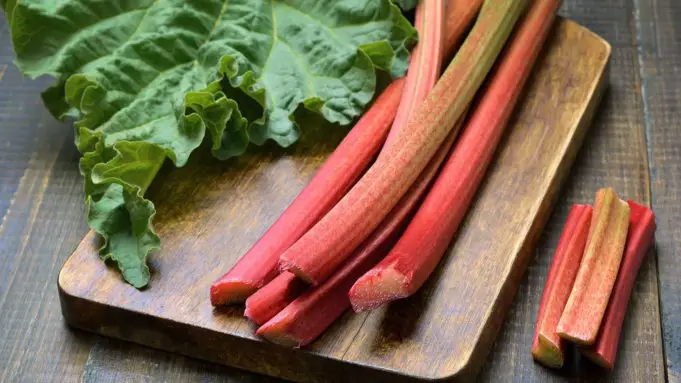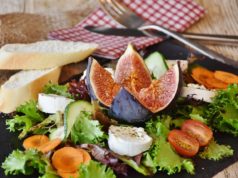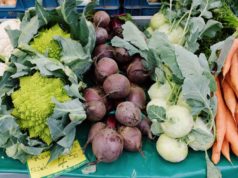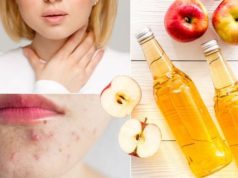Rhubarb (Rheum rhabarbarum) is a vegetable that several people use in cooking and recipes. It grows in many other parts of the world, including the United States, despite its Asian origins. The plant prefers cooler climates since it doesn’t do well in hot weather.
In the spring, the long red leafstalks bloom, peak in mid-April and only the plant’s stalks are edible. Toxins and high levels of oxalic acid are found in the leaves. The stalks are fleshy, bitter, and acidic on their own. While they can be consumed raw, most people prefer them fried.
Rhubarb has a long and illustrious history, dating back to ancient Chinese medicine. It was also used in the ancient cultures of the Arabs, Greeks, and Romans.
Today, it is popular in jams, pies, compotes, and even drinks.
Health advantages
Vitamin K is vital for bone health as well as blood clotting, and rhubarb is a good source. Rhubarb’s vitamin A can also aid in the battle against free radicals that cause skin damage and premature ageing, keeping your skin looking healthy and youthful.
It also contains a lot of antioxidants as well as a lot of other essential vitamins and minerals that have a lot of health benefits. Some health benefits include:
Enhance bone’s health
Rhubarb’s vitamin K content aids in the maintenance of solid, healthy bones. Vitamin K is essential for bone development and can aid in the prevention of osteoporosis.
Safeguard heart health
Rhubarb is high in fibre, which helps to reduce cholesterol levels. Rhubarb has been shown in studies to help reduce cholesterol levels. Plus, it reduces the risk of heart disease and heart attack by lowering your cholesterol levels. Rhubarb contains vitamin K, which can help to prevent blood vessel calcification.
The antioxidants in the vegetable have anti-inflammatory properties, which can help protect your heart health even more.
Aids digestion
Rhubarb’s fibre helps keep things going through your digestive tract, avoiding constipation and other digestive issues. Sennosides, which serve as natural laxatives, are found in it as well. Rhubarb’s tannins also have anti-diarrheal properties.
Prevent cancer
Rhubarb’s antioxidants help the body combat free radicals, protecting against oxidative stress and cell harm. Antioxidants’ free radical-fighting properties can lower your risk of developing certain cancers.
Reduce Inflammation
Rhubarb’s antioxidant compounds aid in the reduction of inflammation. People suffering from systemic inflammatory reaction syndrome may benefit from these properties.
Another research discovered that rhubarb extract’s anti-inflammatory properties would aid wound healing.
Nutrition

Antioxidants abound in rhubarb, especially anthocyanins (which give it its red colour) and proanthocyanidins.
Anti-bacterial, anti-inflammatory, and anti-cancer effects of these antioxidants help protect you from various health problems, including heart disease, cancer, and diabetes.
Some other nutrients present in rhubarb include:
- Vitamin A
- Vitamin C
- Vitamin K
- Folate
- Calcium
- Potassium
- Magnesium
- Manganese
Nutrients Per Serving
A half-cup serving of rhubarb contains:
- Protein: 1 gram
- Fat: 0 grams
- Fibre: 1 gram
- Carbohydrates: 3 grams
- Calories: 13
- Sugar: 1 gram
Things to Be Aware Of
Rhubarb contains a lot of calcium oxalate. The substance is mostly present in the leaves, but it can also be found in the stalks. Too much calcium oxalate in your diet can cause hyperoxaluria, a condition in which oxalate crystals build up in various organs.
These crystals can also increase the risk of kidney failure by promoting the development of kidney stones.
Rhubarb’s vitamin K content can also interact with the blood-thinning drug warfarin. If you want to include rhubarb in your diet, talk to your doctor first. It may reduce the effectiveness of your medication.
How to eat rhubarb
When the vegetable is in season, usually from April to June, you can find fresh rhubarb in your grocery store’s produce category.
Look for firm, crisp rhubarb stalks when buying rhubarb. Those that are limp or have blemishes should be avoided.
Smaller leaves suggest a younger plant. However, cut the leaves before cooking or feeding. If you don’t cut the stalks before you’re ready to use the rhubarb, it will dry out. Place entire stalks in a sealed plastic bag in the refrigerator to store.
Use them within a week of buying them. If you would like to save your rhubarb for later use, break it up and freeze the bits until you’re ready to use them.
Rhubarb can be enjoyed in a variety of ways that include raw, blended into a smoothie, or baked into a rhubarb jelly.
There are a variety of other ways to eat the vegetable, including:
- Using it to make a pastry or crumble
- Making rhubarb ice cream
- Rhubarb may be added to fresh juices or homemade kombucha.
- Using it to make a meat or poultry sauce
- To make rhubarb leather, puree it and dehydrate it.
- Tossing rhubarb in a salad after roasting it with a drizzle of honey
Reference;
- Health Benefits of Rhubarb – webmd












